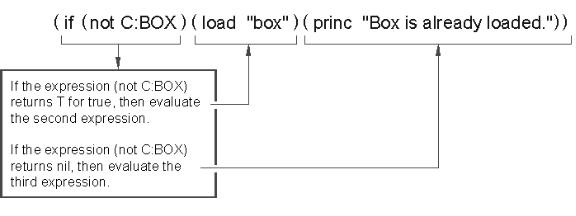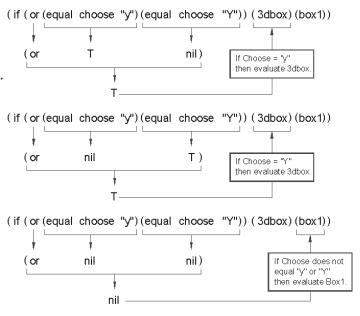
- •Introduction
- •Who should read this book
- •How This Book Is Organized
- •How to Use This Book
- •Where to Find the LISP Programs
- •CHAPTER 1: Introducing AutoLISP
- •Understanding the Interpreter and Evaluation
- •The Components of an Expression
- •Using Arguments and Expressions
- •Using Variables
- •Understanding Data Types
- •Integers and Real Numbers
- •Strings
- •Lists
- •File Descriptors
- •Object Names
- •Selection Sets
- •Symbols
- •Subrs
- •Atoms
- •Assigning Values to Variables with Setq
- •Preventing Evaluation of Arguments
- •Applying Variables
- •Functions for Assigning Values to Variables
- •Adding Prompts
- •CHAPTER 2: Storing and Running Programs
- •Creating an AutoLISP Program
- •What you Need
- •Creating an AutoLISP File
- •Loading an AutoLISP file
- •Running a Loaded Program
- •Understanding How a Program Works
- •Using AutoCAD Commands in AutoLISP
- •How to Create a Program
- •Local and Global Variables
- •Automatic Loading of Programs
- •Managing Large Acad.lsp files
- •Using AutoLISP in a Menu
- •Using Script Files
- •CHAPTER 3: Organizing a Program
- •Looking at a Programs Design
- •Outlining Your Programming Project
- •Using Functions
- •Adding a Function
- •Reusing Functions
- •Creating an 3D Box program
- •Creating a 3D Wedge Program
- •Making Your Code More Readable
- •Using Prettyprint
- •Using Comments
- •Using Capitals and Lower Case Letters
- •Dynamic Scoping
- •CHAPTER 4: Interacting with the Drawing Editor
- •A Sample Program Using Getdist
- •How to Get Angle Values
- •Using Getangle and Getorient
- •How to Get Text Input
- •Using Getstring
- •Using Getkword
- •How to Get Numeric Values
- •Using Getreal and Getint
- •How to Control User Input
- •Using Initget
- •Prompting for Dissimilar Variable Types
- •Using Multiple Keywords
- •How to Select Groups of Objects
- •Using Ssget
- •A Sample Program Using Ssget
- •CHAPTER 5: Making Decisions with AutoLISP
- •Making Decisions
- •How to Test for Conditions
- •Using the If function
- •How to Make Several Expressions Act like One
- •How to Test Multiple Conditions
- •Using the Cond function
- •How to Repeat parts of a Program
- •Using the While Function
- •Using the Repeat Function
- •Using Test Expressions
- •CHAPTER 6: Working With Geometry
- •How to find Angles and Distances
- •Understanding the Angle, Distance, and Polar Functions
- •Using Trigonometry to Solve a Problem
- •Gathering Information
- •Finding Points Using Trigonometry
- •Functions Useful in Geometric Transformations
- •Trans
- •Atan
- •Inters
- •CHAPTER 7: Working with Text
- •Working With String Data Types
- •Searching for Strings
- •Converting a Number to a String
- •How to read ASCII text files
- •Using a File Import Program
- •Writing ASCII Files to Disk
- •Using a Text Export Program
- •CHAPTER 8: Interacting with AutoLISP
- •Reading and Writing to the Screen
- •Reading the Cursor Dynamically
- •Writing Text to the Status and Menu Areas
- •Calling Menus from AutoLISP
- •Drawing Temporary Images on the Drawing Area
- •Using Defaults in a Program
- •Adding Default Responses to your Program
- •Dealing with Aborted Functions
- •Using the *error* Function
- •Organizing Code to Reduce Errors
- •Debugging Programs
- •Common Programming Errors
- •Using Variables as Debugging Tools
- •CHAPTER 9: Using Lists to store data
- •Getting Data from a List
- •Using Simple Lists for Data Storage
- •Evaluating Data from an Entire List at Once
- •Using Complex Lists to Store Data
- •Using Lists for Comparisons
- •Locating Elements in a List
- •Searching Through Lists
- •Finding the Properties of AutoCAD Objects
- •Using Selection Sets and Object Names
- •Understanding the structure of Property Lists
- •Changing the properties of AutoCAD objects
- •Getting an Object Name and Coordinate Together
- •CHAPTER 10: Editing AutoCAD objects
- •Editing Multiple objects
- •Improving Processing Speed
- •Using Cmdecho to Speed up Your Program
- •Improving Speed Through Direct Database Access
- •Filtering Objects for Specific Properties
- •Filtering a Selection Set
- •Selecting Objects Based on Properties
- •Accessing AutoCAD's System Tables
- •CHAPTER 11: Accessing Complex Objects
- •Accessing Polyline Vertices
- •Defining a New Polyline
- •Drawing the new Polyline
- •Testing for Polyline Types
- •How Arcs are Described in Polylines
- •Accessing Object Handles and Block Attributes
- •Using Object Handles
- •Using Object Handles
- •Extracting Attribute Data
- •Appendix A: Menu Primer
- •Appendix B: Error Messages
- •Appendix C: Group Codes
The ABC’s of AutoLISP by George Omura
Chapter 5: Making Decisions with AutoLISP
Introduction
Using the Cond Function
Making decisions
How to repeat parts of a program
How to test for conditions
Using the While Function
Using the If function
Using the Repeat Function
How to make several expressions act like one
Using Test expressions
How to test Multiple Conditions
Conclusion
Introduction
As we mentioned in chapter 3, AutoLISP is designed to help us solve problems. One of the key elements to problem solving is the ability to perform one task or another based on some existing condition. We might think of this ability as a way for a program to make decisions. Another element of problem solving is repetitive computation. Something that might be repetitive, tedious, and time consuming for the user to do may be done quickly using AutoLISP. In this chapter, we will look at these two facilities in AutoLISP.
Making Decisions
You can use AutoLISP to create macros which are like a predetermined sequence of commands and responses. A macro building facility alone would be quite useful but still limited. Unlike macros, AutoLISP offers the ability to perform optional activities depending on some condition. AutoLISP offers two conditional functions that allow you to build-in some decision making capabilities into your programs. These are the if and cond functions. If and cond work in very similar ways with some important differences.
How to Test for Conditions
The if functions works by first testing to see if a condition is met then it performs one option or another depending on the outcome of the test. This sequence of operations is often referred to as an if-then-else conditional statement. if a condition is met, then perform computation A, else perform computation B. As with all else in AutoLISP, the if function is used as the first element of an expression. It is followed by an expression that provides the test. A second
91
Copyright © 2001 George Omura,,World rights reserved
The ABC’s of AutoLISP by George Omura
and optional third argument follows the test expression. The second argument is an expressions that is to be evaluated if the test condition is true. If the test returns false or nil, then if evaluates the third argument if it exists, otherwise if returns nil. The following shows the general syntax of the if function.
(if (test expression)
(expression) (optional expression)
)
The test expression can be use any function but often you will use two classes of functions called predicates and logical operators. Predicates and logical operators are functions that return either true or false. Since these functions don't return a value the way most functions do, the atom T is used by predicates and logical operators to represents a non-nil or true value. There are several functions that return either a T or nil when evaluated.
FUNCTION |
RETURNS T (TRUE) IF... |
Predicates |
|
< |
a numeric value is less than another |
> |
a numeric value is greater than another |
<= |
a numeric value is less than or equal to another |
>= |
a numeric value is greater than or equal to another |
= |
two numeric or string values are equal |
/= |
two numeric or string values are not equal |
eq |
two values are one in the same |
equal |
two expressions evaluate to the same value |
atom |
an object is an atom (as opposed to a list) |
boundp |
a symbol has a value bound to it |
listp |
an object is a list |
minusp |
a numeric value is negative |
numberp |
an object is a number, real or integer |
zerop |
an object evaluates to zero |
Table 5.1 A list of AutoLISP predicates and logical operators.
92
Copyright © 2001 George Omura,,World rights reserved
The ABC’s of AutoLISP by George Omura
Logical Operators |
|
and |
all of several expressions or atoms return non-nil |
not |
a symbol is nil |
null |
a list is nil |
or |
one of several expressions or atoms return non-nil |
Table 5.1 (continuet) A list of AutoLISP predicates and logical operators.
You may notice that several of the predicates end with a p. The p denotes the term predicate. Also note that we use the term object in the table. When we say object, we mean any lists or atoms which include symbols and numbers. Numeric values can be numbers or symbols that are bound to numbers.
All predicates and logical operators follow the standard format for AutoLISP expressions. They are the first element in an expression followed by the arguments as in the following example:
( > 2 4 )
The greater than predicate compares two numbers to see if the one on the left is greater than the one on the right. The value of this expression is nil since two is not greater than four.
The predicates >,<,>=, <= all allows more than two arguments as in the following:
( > 2 1 5 8 )
When more than two arguments are used, > will return T only if each value is greater than the one to is right. The above expression returns nil since 1 is not greater than 5.
The functions and, not, null and or are similar to predicates in that they too return T or nil. But these functions, called logical operators, are most often used to test predicates (see table 5.1). For example, you could test to see if a value is greater than another:
(setq val1 1)
(zerop val1)
nil
93
Copyright © 2001 George Omura,,World rights reserved

The ABC’s of AutoLISP by George Omura
We set the variable val1 to 1 then test to see if val1 is equal to zero. The zerop predicate returns nil. But suppose you want to get a true response whenever val1 does not equal zero. You could use the not logical operator to "reverse" the result of zerop:
(setq val1 1)
(not (zerop val1))
T
Since not returns true when its argument returns nil, the end result of the test is T. Not and null can also be used as predicates to test atoms and lists.
Using the If function
In chapter 2, you saw briefly how the if function worked with the not logical operator to determine whether to load a program or not. Looking at that expression again (see Figure 5.1), you see a typical use of the if function.
Figure 5.1: An expression showing the syntax for the If function
This function tests to see if the function C:BOX exists. If C:BOX doesn't exist, it is loaded. This simple program decides to load a program based on whether the program has already been loaded. The test function in this case is not. Lets look at how you might apply if to another situation. In the following exercise, you will add an expression to decide between drawing a 2 dimensional or 3 dimensional box.
94
Copyright © 2001 George Omura,,World rights reserved
The ABC’s of AutoLISP by George Omura
1.Open the Box1.lsp file.
2.Change the first line of the Box program so it reads as follows:
(defun BOX1 (/ pt1 pt2 pt3 pt4)
By removing the C: from the function name, Box1 now becomes a function that can be called from another function.
3.Change the first line of the 3dbox program so it reads as follows:
(defun 3DBOX (/ pt1 pt2 pt3 pt4)
4.Add the program listed in boldface print in figure 5.2 to the end of the Box1.lsp file. Your Box1.lsp file should look like figure 5.2. You may want to print out Box1.lsp and check it against the figure.
5.Save and Exit Box1.lsp.
6.Open an AutoCAD file called chapt5. Be sure to use the = suffix with the file name.
7.Load the box1.lsp file.
8.Run the Mainbox program by entering mainbox at the command prompt. You will see the following prompt:
Do you want a 3D box <Y=yes/Return=no>?
9.Enter y. The 3dbox function executes.
95
Copyright © 2001 George Omura,,World rights reserved

The ABC’s of AutoLISP by George Omura
(defun getinfo ()
(setq pt1 (getpoint "Pick first corner: ")) (princ "Pick opposite corner: ")
(setq pt3 (rxy))
)
(defun procinfo ()
(setq pt2 (list (car pt3) (cadr pt1))) (setq pt4 (list (car pt1) (cadr pt3)))
)
(defun output ()
(command "line" pt1 pt2 pt3 pt4 "c" )
)
(defun BOX1 (/ pt1 pt2 pt3 pt4) (getinfo)
(procinfo)
(output)
)
(defun 3DBOX (/ pt1 pt2 pt3 pt4 h) (getinfo)
(setq h (getreal "Enter height of box: ")) (procinfo)
(output)
(command "change" "L" "" "P" "th" h ""
"3dface" pt1 pt2 pt3 pt4 "" "3dface" ".xy" pt1 h ".xy" pt2 h ".xy" pt3 h ".xy" pt4 h ""
)
)
(defun C:3DWEDGE (/ pt1 pt2 pt3 pt4 h) (getinfo)
(setq h (getreal "Enter height of wedge: ")) (procinfo)
(output)
(command "3dface" pt1 pt4 ".xy" pt4 h ".xy" pt1 h pt2 pt3 "" "3dface" pt1 pt2 ".xy" pt1 h pt1 ""
"copy" "L" "" pt1 pt4
)
)
(defun C:MAINBOX ()
(setq choose (getstring "\nDo you want a 3D box <Y=yes/Return=no>? ")) (if (or (equal choose "y")(equal choose "Y"))(3dbox)(box1))
)
Figure 5.2: The BOX1.LSP file with C:MAINBOX added.
96
Copyright © 2001 George Omura,,World rights reserved

The ABC’s of AutoLISP by George Omura
In this example, you first turned the programs C:BOX1 and C:3DBOX into functions by removing the C: from their names. Next, you created a control program called C:MAINBOX that prompts the user to choose between a 2 dimensional or 3 dimensional box. The first line in the C:MAINBOX program, as usual, gives the program its name and determines the local variables. The next line uses the Getstring function to obtain a string value in response to a prompt:
(setq choose (getstring "\nDo you want a 3D box <Y=yes/Return=no>? "))
The prompt asks the user if he or she wants a 3 dimensional box and offers the user two options, Y for yes or Return for no. The third line uses the if function to determine whether to run the BOX1 or 3DBOX function. Notice that the or and the equal predicates are used together.
(if (or (equal choose "y")(equal choose "Y"))(3dbox)(box1))
The or function returns T if any of its arguments returns anything other than nil. Two arguments are provided to or. One test to see of the variable choose is equal to the lower case y while the other checks to see if choose is equal to an upper case y. If the value of either expression is T, then or returns T. So, if the user responds by entering either an upper or lower case y to the prompt in the second line, then the or predicate returns T. Any other value for choose will result in a nil value from or (see figure 5.3).
Figure 5.3: Using the logical operator Or
97
Copyright © 2001 George Omura,,World rights reserved
